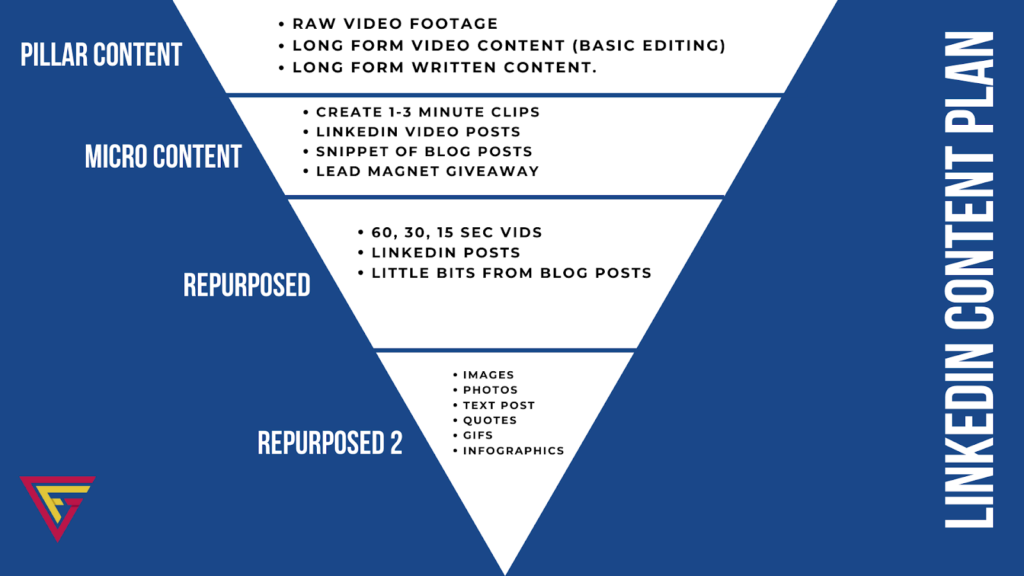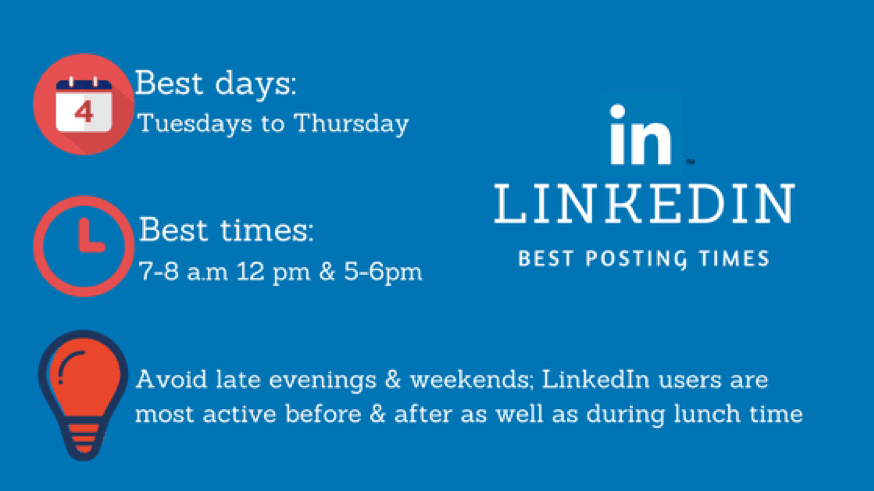How to Master Your LinkedIn Content Marketing Plan in 2022

Table of Contents
- Why is LinkedIn Important for Content Marketing
- 5 Best Practices for LinkedIn Content Creation
- How to Distribute Content on LinkedIn
- Key Takeaways
- Conclusion
- FAQs
Linkedin is the ‘it’ place for finding, qualifying, nurturing, and finally converting B2B leads. More than 92% of B2B leads come from LinkedIn. That’s why it’s the go-to social networking platform for industry professionals.
It is also a great platform for distributing thought leadership content and slowly building your brand image. For that, you require a solid LinkedIn content marketing plan that will sync with your marketing efforts.
Valuable content, when exposed to a niche audience of LinkedIn can do wonders for your brand. But there are several nuances of a good LinkedIn content strategy.
Up next, we will discuss why LinkedIn has huge potential for content marketing. We will also talk about the best practices for content creation on LinkedIn. And this will be further refined with a content distribution strategy for the platform. So let’s begin!
Why is LinkedIn Important for Content Marketing
As per LinkedIn’s Sophisticated Marketer’s Guide to LinkedIn, more than 94% of B2B marketers prefer LinkedIn for content distribution over other platforms. And there are plenty of reasons why. Some of them are listed below:
Greater exposure
LinkedIn has over 600 million professionals who are part of its community. Most of them engage with the platform actively and look for meaningful content. Thus, it’s a great place to be visible and get exposure to potential clients or stakeholders.
Since LinkedIn is primarily used for industry-relevant content, unlike other social networks, your content is likely to grab more eyeballs. Moreover, LinkedIn’s content distribution algorithms work on the Domino effect. So, if someone in your network likes or engages with your content, people from their network will also see it in their feed.
Targetted audience
LinkedIn has a good network of millennial professionals, including over 11 million decision-makers. These professionals solely scroll through LinkedIn intending to consume valuable thought leadership content and network.
Thus, you are more likely to catch the right people’s attention in the hierarchy using a platform like LinkedIn. If you are consistently writing SEO articles, they will easily remember and recall your brand.
Cost-effective
Lead generation can be very expensive using outbound techniques like ads, email marketing, etc. But content marketing on LinkedIn is one of the most cost-effective ways to get inbound leads.
Since inbounds leads are already interested in your services, you spend fewer resources on qualifying and nurturing them. You can redirect these saved funds to strengthen your content strategy.
Long-term results
Sharing valuable content on LinkedIn is not just for short-term gains like leads. It also helps in building the authority of your brand in the industry. As you share content, many people will interact with it. These people may not be in immediate need of your services. But you can consider them potential leads that may get in touch later.
5 Best Practices for LinkedIn Content Creation
Content marketing on LinkedIn is easy with the right strategy and execution. Here are five solid tips on how to master LinkedIn content marketing.

1. Focus on value
Every brand is trying to promote itself on social platforms. What is going to be different about you? Value. Instead of bombarding your followers with meaningless promotions, make them a part of an exclusive value club. They should be able to derive insights from your content that they didn’t find anywhere else.
Whether it’s in the form of industry analysis, opinions, best practices, or some other bits of value, your content should be able to provide them with some takeaways.
That is why thought leadership content is well-appreciated by the LinkedIn audience. It helps establish your brand as an expert and gets your readers to keep coming back for more value.
2. Engage with the readers
Any content that fails to engage with the readers will fail to deliver results. People scrolling through social media have an attention span shorter than a goldfish. They won’t spare their precious time on long, drab, uninteresting monologue for information.

People prefer content that will directly speak to them, encourage them to engage, and holds their eye. That’s why formats like polls, quizzes, carousels, etc. work great on LinkedIn nowadays.
The better your content can engage people, the more likely they will remember your brand. A good way to keep content engaging is by telling stories. People love listening to relatable, corporate anecdotes that reflect their own lives. Incorporate this into your LinkedIn strategy for content marketing.
3. Be consistent in sharing content
Three million people create content on LinkedIn. But people will only remember those who show up consistently. The more your name pops up on their screens, the stronger your bond with them will become. Even the LinkedIn algorithm favors creators and brands consistent in their content distribution.

But many people confuse consistency with frequency. To be successful with your LinkedIn content marketing strategy, you don’t need to post many times a day.
In fact, even posting daily is not a hard and fast rule. All you need to do is maintain a consistent frequency. If you post once a day, never miss a day. If you post twice a week, fix two days and stick to them. The LinkedIn algorithm, as well as the audience, will reward you for showing up.
4. Utilize different content formats
Most marketers make the mistake of sticking to a few content formats that work for them. This leaves little room for improvement. Make sure you allow some space on your social media calendar for different content formats.
Play around with videos, stories, carousels, polls, and other formats often. This way, you will keep your audience engaged and maintain a surprise element. LinkedIn also encourages the use of new formats and rewards creators with more visibility.
5. Utilize user-generated content
It’s not just you who has to talk about your company. It’s smarter to also utilize user-genrated content about your brand in your LinkedIn content marketing strategy.
Encourage your customers, employees, and other stakeholders to share stories about your brand. You can engage with such posts and strengthen your connection with your customers.
However, tread carefully with this strategy. If user-geenrated content is not moderated, it can also lead to negative PR for the brand by fueling controversies.
How to Distribute Content on LinkedIn
Here are some tips on how to distribute content effectively on LinkedIn.

Maintain a Content Calendar
It’s important to create a social media calendar specific to LinkedIn. Specify any important dates, events, and festivals beforehand. Plan at least one month’s worth of content ahead, but leave some space for Adhoc posts. A content calendar will help you remain consistent with your LinkedIn content strategy.
Share links to useful resources
It’s a quick and effective way of providing value to your LinkedIn audience. You can share links to insightful articles, videos, studies, and reports published on other platforms. It will help in cross-promotion and also keep your audience engaged.
Mention people wherever needed
It’s good to tag people and brands in posts you share whenever relevant. By doing this, you will also expose your content to their networks. People are also more open to engaging with posts they’ve been tagged in.
Organize industry events
Events like webinars, workshops, and panel discussions are a great way to attract key decision-makers. You can talk about the events you are attending to get more footfall. It also helps build your image as a thought leader.
Key Takeaways
- Content marketing on LinkedIn can be a gamechanger for companies and creators. LinkedIn provides more exposure in the industry, target audience of decision-makers, savings on marketing cost, and long-term results.
- Lay more focus on providing your readers with value. Spare the promotional jargon and stick to useful insights that your audience will appreciate.
- Drab, monotonous pieces of information will do more harm than good. Storytelling can be leveraged to keep your readers hooked to the content.
- Consistency is more important than the frequency of posting content. Plan your content frequency ahead and stick to it as much as possible.
- Don’t restrict yourself to certain content formats. Experiment and keep them changing for higher engagement.
- You need not bear the entire responsibility of creating content for your brand. Let your customers and key stakeholders share the job. Make use of user-generated content to build stronger relationships.
- Distribution is equally important in LinkedIn content strategy. Maintain a social media content calendar, share external resources, mention people frequently, and exploit industry events to attract target clients.
Conclusion
That’s a wrap on how to master your LinkedIn content marketing plan. Linkedin can be a powerful tool for business growth if appropriately utilized.
Content marketing on LinkedIn comes with its own perks and challenges. But with consistent effort and value-driven content, you can establish a strong presence for your brand on the platform.
The LinkedIn content strategy we shared is relevant to any brand or individual looking to start content creation on the platform.
FAQs
Mastering LinkedIn content strategy is all an equation of consistency and value. If you take valuable content and deliver it consistently, you will see results on LinkedIn.
Start with your overall objective for LinkedIn marketing. Next, finalize a list of broad themes to cover and a schedule. Then, allocate a budget and specify teams/individuals to execute the plan.
Start by sharing regular content and engaging with other people’s content. This will get you more visibility. Top it up with unique content specific to your LinkedIn page to motivate people to follow.
Create content that provides value to decision-makers. It includes industry reports, infographics, statistics, and well-researched opinions. This makes your brand look trustworthy and attracts more leads.
Latest Blogs
Learn how to rank on AI search engines like ChatGPT, Perplexity, and Gemini by optimizing your content for authority, structure, and relevance. Stay ahead in AI-driven search with this strategic guide.
Explore the best healthcare SEO services for your medical practice. Improve online visibility and effectively reach more patients in need of your services.
Discover top social media agencies specializing in banking solutions, enhancing financial services and driving engagement.
Get your hands on the latest news!
Similar Posts

Content Marketing
4 mins read
11 Best B2B Content Marketing Agencies for B2B Companies in 2024

Content Marketing
5 mins read
Top ecommerce Marketing Agencies with Proven Strategies for 2024

Content Marketing
5 mins read